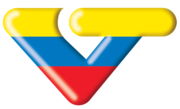Venezolana de Televisión
| Venezolana de Televisión | |
|---|---|
 |
|
| Launched | August 1, 1964 |
| Owned by | State-Owned Enterprise under administration of the Ministry of Popular Power for Communication and Information |
| Picture format |
480i (4:3 SDTV) 1080i (16:9 HDTV) |
| Slogan | The Channel of all Venezuelans (Spanish: El Canal de todos los Venezolanos) We Are..... (Spanish: Somos......) |
| Language | Spanish |
| Broadcast area | Venezuela, Latin America, United States, Spain, Portugal |
| Affiliates |
ANTV Avila TV Buena Televisión teleSUR ViVe |
| Headquarters | Caracas, Venezuela |
| Website | VTV.gob.ve |
|
Availability
|
|
| Terrestrial | |
| Local VHF Venezuela | Channel 8 (Caracas and most of the country) |
| Satellite | |
| Direct TV Venezuela | Channel 108 |
| Cable | |
| Intercable Venezuela | Channel 8 |
| NetUno Venezuela | Channel 7 |
| Supercable Venezuela | Channel 8 |
| Movistar TV Venezuela | Channel 138 |
| CANTV Venezuela | Channel 3 |
| Inter Venezuela | Channel 7 and 8 |
| NOS Portugal | Channel 224 |
| Streaming media | |
| VTV | Watch live |
Corporación Venezolana de Televisión (Spanish for: Venezuelan Television Corporation) or VTV (Spanish pronunciation: [beteˈβe]) is a public television network based in Caracas, Venezuela, which can be seen throughout the country on channel eight. Programs that can be seen on VTV include Aló Presidente and Noticias TeleSUR.
VTV has produced a number of telenovelas, including titles such as Ifigenia, Doña Perfecta, and La Dueña. 1984's La Dueña was perhaps its most successful and popular production. In 2004, VTV produced another telenovela, Amores de Barrio Adentro, but it was only seen once a week and lasted only a few months. In August 2014, VTV celebrated its 50th anniversary.
Cadena Venezolana de Televisión (CVTV) was inaugurated as a privately owned television station on August 1, 1964, at 7:30 p.m. President Raúl Leoni was chosen to be the one to cut the ribbon. Despite its name, however, it was not a nationwide television network at first, broadcasting in the Caracas area during its first years. Only in the late 1960s did the channel become a national network with the opening of stations in major cities nationwide, and became the first network to produce and broadcast a color program in 1971.
In September 1974, CVTV, after prolonged financial problems due to its competition with the better-established privately owned television networks in Venezuela, Radio Caracas Televisión and Venevisión, was purchased by the Venezuelan government and rebranded as Venezolana de Televisión (VTV). Between 1974 and 1980, VTV was funded in whole by the government, but due to an internal economic crisis, VTV was forced to air advertisements for extra revenue (this has no longer been occurring since Hugo Chávez became president in 1999). It now only broadcasts program previews and government ads instead.
...
Wikipedia
